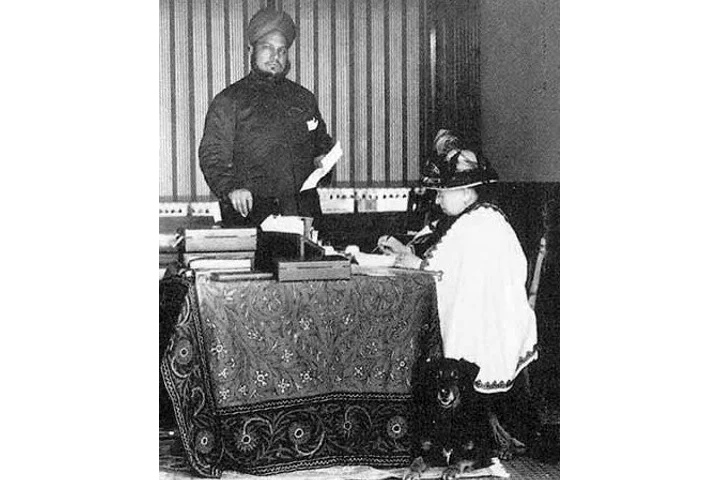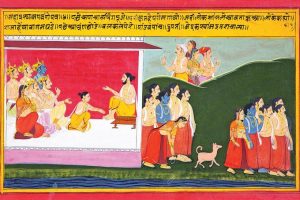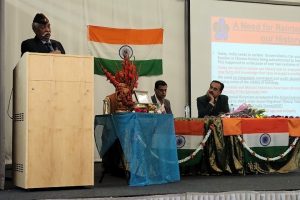As England, and some of the world, has stood riveted by the rituals of mourning around the death of queen Elizabeth II, and questions as to the relevance of the monarchy in the modern world are doing the rounds, it may be on interest to readers of this column to discover how the British monarchy, and Colonialism, impacted India’s vast and deep culinary cultures.
Queen Elizabeth II’s great great grandmother was Queen Victoria who reigned from 1837 to 1901, a period when colonial power in India took deep roots and a chunk of the Subcontinent came directly under the British crown (after the 1857 revolt). By 1887, Victoria was ready to celebrate the golden jubilee of her rule over not just the UK but an empire on which it was said the sun never set, and which spanned many subjugated people from the West Indies to the east. But on a personal level, the queen was interested enough in India to ask for an Indian servant to help serve at a banquet for heads of states to mark her jubilee.
Queen #Victoria‘s love of Indian food was the subject of #TheBestOfBritishTakeaways last night on @BBCTwo https://t.co/eky3tuqsKh from 40min pic.twitter.com/nZJi6oguvu
— Osborne (@EHOsborneHouse) March 29, 2017
Abdul Karim was procured as a “gift” for her from Agra, according to the journalist Shrabani Basu, who discovered the deep and intimate relationship between the queen and her brown servant and wrote a book about it, which became the basis for the movie Victoria and Abdul. Once Karim entered the queen’s service, he was able to impress her not just to become her closest confidante but also with his version of the chicken curry and pilau, which were incorporated into the queen’s regular meal rotation according to A N Wilson, a biographer of Victoria.
Victoria and Abdul, a thread
Born in 1863 as the second eldest of 6 to a hospital attendant in Lalitpur , Abdul Karim was presented to Queen Victoria along with another male Indian to serve during the Queens Golden Jubilee. pic.twitter.com/pO2YmoqUP3
— Kate’s Rangers (@kates_rangers) April 4, 2022
With the empress herself putting the curry regularly at her dining table, it became a fashion in Victorian England to indulge in weekly “curry” —a practice that would later solidify into curry houses, and the ritualistic weekly indulgence in “curry” by most English families, even though that curry was (and is) unlike anything that Indians eat at home, where even the word “curry” is not used to describe diverse and nuanced regional and seasonal preparations with specific spices.
Upon Victoria’s death in 1901, her son Edward demanded any correspondence between the empress and her close confidant to be burnt. Victoria’s daughter Beatrice erased all references to Abdul in the queen’s journal—though portraits of him commissioned by the queen survived. The reason for this was racial prejudice. Historian Carolly Erickson writes in Her Little Majesty: “For a dark skinned Indian to be very nearly on a level with the queen’s white servants was all but intolerable, for him to eat at the same table with them, to share in their daily lives was viewed as an outrage”.
If this prejudice was part of Europe’s colonial enterprise, a fascination with the exotic “Oriental” was the flip side of the same. Edward Said, of course, has written about “Orientalism” and its construction in his seminal work, but even in food books and references to figures that would play a key role in popularising the exotic east and its “potent” tastes, we can see the exoticising of the east by the west.
Sake Dean Mahomed (1759-1851) was one of the most notable early Indian immigrants to Europe/England, his title “sake” being a corruption of the word “sheikh”. He was a surgeon and an entrepreneur and wrote an account called The Travels of Dean Mahomet (1794) about his travels from Patna, eventually part of the Bengal Presidency to Britain, where he died in Brighton in 1851 (after opening the Brighton Bath house), and where he was alternately known as Dr Brighton too.
Dean Mahomed introduced “shampoo” to the western world—offering therapeutic “champi” massage at his Brighton Bath house to a western clientele; the word shampoo is a corruption of “champi”, the traditional Indian head massage with oil. But among his other lesser known contributions is also the setting up of the first Indian restaurant in the west. In 1810, when Dean Mahomed moved to London, he opened the Hindoostane Coffee House near Portman Square in central London, which offered, among other things, hookah “with real chilm tobacco, and other Indian dishes…allowed by the greatest epicures to be unequalled to any curries ever made in England”. A plaque commemorates the place where the original restaurant once stood.
In 1810: Deen Mohd established the 1st Indian restaurant in England: the Hindoostane Coffee House in London in 1810 pic.twitter.com/1jyAiG4tuG
— Mohandas Menon (@mohanstatsman) May 31, 2015
Dean Mahomed was ahead of his times and curry would take off in England only with Victoria’s patronage, but his business idea of serving “Indianised British food” suitable to English palates—mild spices, a touch of the exotic oriental– would in fact get replicated repeatedly through the centuries till quite recently when Frenchified Indian restaurants in London in the 1990s served up fare that was essentially European but with Indianish flavours to appease western palates who did not seem to understand the true complexity or nuance of regional Indian cooking. Veeraswamy, which is now owned by Camellia and Namita Panjabi (Camellia was the culinary director at the Taj and the key to setting up its iconic restaurants such as the Bombay brasserie that put Mumbai’s street food in a five star setting, and was pathbreaking), is today London’s oldest Indian restaurant. But when it opened in the 1920s, when India was still under the crown, its ownership was white English – Edward Palmer opened it in Piccadilly in 1926, serving the same idea of Dean Mahomed’s food, but by this time thanks to the Victorian and Regency eras, curry was more accepted, and Veeraswamy made Indianish food highly fashionable.
A3 I love Bombay Brasserie. It is awesome. #travelchatSA pic.twitter.com/QyMKvWEngd
— Dorothée Lefering (@DoroLef) May 15, 2019
While the generic “curry” became the most popular British dinner, some specific dishes and condiments too seem to have been invented with what we can now see as a sort of cultural appropriation. Scotch eggs are mentioned in iconic English cookery books of the 19th century, including Mrs Beeton’s Book of Household Management that was instrumental in shaping middle class Victorian identity in many ways. It was a highly influential tome, though post- colonial writers have since pointed out how Mrs. Beeton in fact plagiarised recipes, without crediting them.
Scotch eggs make an appearance in these 19th century books as a dinner dish—eggs encased in mince, in a little gravy. The Oxford Companion To Food suggests the real origin to have been the Indian kofta. The Lucknowi dish Nargisi Kofta to be more specific, which still exists in India, though is a disappearing delicacy. Named after the narcissus flower or “nargis”, the name is typical of Lucknowi hyperbolic nomenclature for dishes often named after flowers, birds and beauty in nature—the idea being that when the kofta is cut, the contrasting white and yellow of the egg inside the brown keema casing would resemble the nargis flower.
At some point in the 19th century, the Scotch egg became dry and bread crumb coating was suggested to hold the mince, not there in the Indian kofta recipe. This is the popular snack now that you find all over the UK. Nothing Scotch about it.
SCOTCH EGGS!
recipe @ https://t.co/r49l2D6W1f pic.twitter.com/zBhnRNe89G— SURYZ (@suryzcooking) September 19, 2022
The worcestershire sauce that we now know as a popular condiment in Continental restaurants is also a 19th century innovation with an Indian legacy that is hidden and unacknowledged. A fermented sauce containing many “secret” ingredients, it was created by the pharmacists John Wheeley Lea and Willian Henry Perrin, and contains vinegar, anchovies, tamarind, garlic, onions, molasses as well as “spices”. Lea and Perrins, the original makers, floated a story that the sauce was based on a recipe from the kitchen of a governor general of Bengal, who had asked local Indian apothecaries to develop it! It was supposed to help in digestion too. The “spices” are not mentioned on the label, but it is now widely conjectured that hing or asafoetida, long the mainstay of Indian pickling, is an essential ingredient of the sauce giving it a burst of umami. Rotting fish may in fact have been pickled like in the achar tradition by a colonialist who accidentally contributed to the invention of a global condiment!
At the height of British imperialism, Calcutta was known as the second city of the British empire, after London. After Victoria’s death, Edwardian fashions—and tastes—that dominated London society from 1901 to 1910, and whose influence stayed on till the start of World War 1 when class and gender structures of traditionally conservative English society were dismantled, seeped into high class, moneyed Indian society of Calcutta too.
English bawarcheekhanas became part of many rich bhadralok homes who had built palatial mansions in Calcutta, where political power of the Indian subcontinent had moved after the Mughal empire disintegrated and Calcutta became the capital of British India, and the empire’s dominions in the east (such as Burma and Malay). In these Angrezee bawarcheekhanas, the bawarchees of yore, whose forefathers had once served Mughal and Avadhi aristocracy, now experimented with Edwardian dishes and Indianised these. In the Tagore home in Jorasanko, it is recorded, the Irish stew, now made in a vegetarian version too, was a favoured dish.
Potato, whose planting had been promoted by the British, was a vegetable preferred by the English at first, but as the taste was acquired by the rich Indian gentry at first and then by the masses, as the ingredient became cheaper, its use grew. Radhaballabi, the UP style traditional kachori that was eaten with halwa as a morning breakfast in old Delhi, Lucknow and eastern UP towns such as Benares, got paired with aloo. Kachori-aloo became a thing.
Pre pujo celebration..
Absolutely gorgeous radhaballabi, cholar dal, alur dom and roshogolla..
Plenty more to come !!@AK_Aspire pic.twitter.com/SJXXLUSMmu
— Rituparna

(@Reineguerrieree) October 5, 2021
The Calcutta chop and cutlet too came into existence at this time. According to Meenakshie Dasgupta in her Calcutta Cookbook, chops were part of the “dry” items invented in upper class homes to keep guests entertained and satiated at weddings who may not have stayed on till the late bhoj needed to be fed.
People on our TL! How many of you know about #MinakshieDasgupta or her books ‘Bangla Ranna’ and ‘The Calcutta Cookbook’? Tell us, tell us! pic.twitter.com/LK9jp2bwok
— APB Cook Studio by Rushina (@APBCookStudio) October 9, 2016
“A plate of dry would consist of fish or meat filled potato chop, a savoury fillet of not fried fish but fish fry with a teaspoon of thinly mixed mustard and a salad of thinly chopped lettuce, beetroot and onions, or if the occasion was special, prawn cutlet. For vegetarians, the chop would be filled with chhana, mocha (green banana) or enchor (green jackfruit) and rolled in poppy seeds”, writes Minakshie Das Gupta.
While the Indian chop, also to be found in the early 20th century in Anglo Indian and Parsi homes, is potato encasing meat of other vegetables such as green peas, the cutlet is distinctly Edwardian with a breadcrumb and eggs coating.
The cutlet was popular in London in the early 1900s. The Cookery of England (Elizabeth Ayrton, 1974) mentions how Edward VII liked his lamb chops—they had to be trimmed, dipped in breadcrumbs, then in egg and breadcrumbs again, and then grilled very fast to turn dark outside but remain juicy and pink inside, served with iced mayonnaise in sauce boats.
Significantly, this dish of lamb chops was called “Cutlets Edwards VII”.
In Calcutta, this cutlet was invented further and the iconic kabiraj created. To cater to the vegetarians, both chops and cutlets included local ingredients such as banana flower and beetroot. These snacks became popular not just in homes but inspired a restaurant culture of their own. Railway restaurants and dining cars and Calcutta’s Cabin style eateries (Anadi in Calcutta dates back to 1915) became aspirational for the Indian middle class that was anglicised. And snacks like the dimer devil, Calcutta’s unique take on devilled eggs that you may have spotted in Downton Abbey trays too, became a sign of fashionable dining.
India’s first restaurant on railway track started in Chhatrapati Shivaji Maharaj Terminus, Mumbai.
Old railway coaches is re-modified into beautiful hotel and placed in platform no. 18 in CSMT!
Great initiative by Indian Railway
pic.twitter.com/dfT1WCGF55
— Aarav Gautam (@IAmAarav8) October 20, 2021
The Edwardian era gentlemen’s Pall Mall clubs that are alluded to in current Netflix favourite Bridgerton, also influenced the emergence of the club culture in big and small towns of India, as well as the Malay, Sri Lanka and so on. With the world wars, as women entered the workforce and class structures were demolished, all these hierarchies of colonialism too were dismantled, first in England and gradually in India.
Also Read: The monsoon magic of Chai Pakoda—did the British East India Company trigger the fusion?























